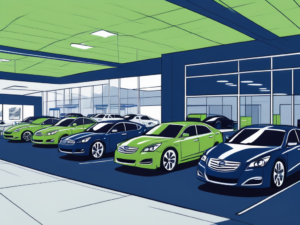Talk to Sales: (401) 200-6026

In today’s competitive business landscape, crafting a winning marketing strategy is crucial for success in any industry. However, when it comes to the automobile industry, the stakes are even higher. With rapidly changing consumer preferences and fierce competition, it is essential for automobile businesses to adopt a well-thought-out marketing strategy that sets them apart from the competition.
Understanding the Automobile Industry
Before diving into the components of a successful marketing strategy for the automobile industry, it is important to have a clear understanding of the industry itself. The automobile industry is a complex network of manufacturers, suppliers, dealers, and consumers. To effectively craft a winning marketing strategy, it is crucial to identify the key players and understand the current trends and challenges.
The automobile industry comprises several key players, including automobile manufacturers, suppliers, and dealers. Automobile manufacturers are responsible for designing, producing, and marketing vehicles. They invest heavily in research and development to create innovative and technologically advanced vehicles that meet the ever-changing demands of consumers. These manufacturers have to carefully analyze market trends, consumer preferences, and regulatory requirements to stay competitive in the industry.
Suppliers, on the other hand, play a critical role in the automobile industry. They provide various components and services to automobile manufacturers. These components can range from engines and transmissions to electronics and interior materials. Suppliers need to maintain strong relationships with manufacturers, ensuring the timely delivery of high-quality components. They also need to stay updated with the latest technological advancements to meet the evolving needs of manufacturers.
Dealers act as intermediaries between the manufacturers and consumers, selling and servicing vehicles. They are responsible for creating a positive buying experience for customers and providing after-sales services. Dealerships often invest in marketing campaigns to attract potential buyers and build brand loyalty. They also offer financing options and maintenance services, ensuring that customers have a hassle-free ownership experience.
Current Trends and Challenges
The automobile industry is constantly evolving, with new trends and challenges emerging on a regular basis. One of the major trends in recent years is the shift towards electric vehicles (EVs) and autonomous driving. Consumers are becoming more environmentally conscious and seeking vehicles that reduce their carbon footprint. Electric vehicles offer a greener alternative to traditional gasoline-powered cars, with zero tailpipe emissions. They also provide a quieter and smoother driving experience. As a result, many automobile manufacturers are investing heavily in developing electric vehicles and expanding their EV product lines.
Another significant trend in the automobile industry is the rise of autonomous driving technology. With advancements in artificial intelligence and sensor technology, self-driving cars are becoming a reality. Autonomous vehicles have the potential to revolutionize transportation by improving safety, reducing congestion, and enhancing mobility for individuals with disabilities. However, the development and deployment of autonomous driving technology face various challenges, including regulatory and legal hurdles, public acceptance, and cybersecurity concerns.
Furthermore, the demand for connected cars is on the rise. Connected cars are vehicles equipped with internet connectivity and advanced technologies that enhance the driving experience. These technologies include features such as navigation, entertainment systems, and connectivity with other devices. Connected cars provide real-time traffic information, enable hands-free calling, and offer seamless integration with smartphones. As consumers become more reliant on technology in their daily lives, the demand for connected cars is expected to grow.
However, with these trends come challenges. Electric vehicles face infrastructure limitations, such as the availability of charging stations. The lack of a widespread charging infrastructure hinders the adoption of electric vehicles, as consumers are concerned about range anxiety and the inconvenience of finding charging stations. Governments and private companies are working together to address this challenge by investing in the development of charging networks and implementing supportive policies.
Autonomous driving technology is still in its early stages and faces regulatory hurdles. Governments around the world are in the process of defining regulations and standards for autonomous vehicles to ensure safety and accountability. Additionally, public acceptance of self-driving cars is crucial for their widespread adoption. Building trust and confidence among consumers regarding the safety and reliability of autonomous vehicles is a significant challenge that the industry needs to overcome.
Keeping up with these trends and overcoming the associated challenges is essential for automobile businesses to thrive in today’s market. Manufacturers, suppliers, and dealers need to adapt their strategies and operations to meet the evolving demands of consumers and the regulatory landscape. By embracing innovation, investing in research and development, and fostering strong partnerships, the automobile industry can continue to drive forward and shape the future of transportation.
Sell cars on the lot faster with AutoRaptor
Know if we’re the right fit within 10 minutes
Components of a Successful Marketing Strategy
A winning marketing strategy for the automobile industry should encompass several key components. These components include defining your target market, positioning your brand, and developing a unique selling proposition that sets you apart from competitors.
Defining Your Target Market
One of the first steps in crafting a winning marketing strategy is defining your target market. Who are your ideal customers? What are their demographics, interests, and purchasing behavior? Understanding your target market allows you to tailor your marketing efforts to effectively reach and engage with them. Conduct thorough market research and gather insights to inform your strategy.
Positioning Your Brand
In a crowded market, it is essential to position your brand in a way that stands out from the competition. This involves crafting a clear and compelling brand identity that resonates with your target market. What makes your brand unique? How do you want your brand to be perceived by consumers? Develop a brand positioning statement that communicates your brand’s value proposition and differentiates you from competitors.
Developing a Unique Selling Proposition
Your unique selling proposition (USP) is what sets your products or services apart from competitors. It is the reason why consumers should choose your brand over others. The key to developing a strong USP is to identify a specific aspect of your product or service that solves a problem for consumers or provides a unique benefit. Highlight this USP in your marketing messaging and emphasize how it delivers value to your target market.
Digital Marketing in the Automobile Industry
In today’s digital age, a winning marketing strategy for the automobile industry cannot neglect the power of online marketing. From establishing a strong online presence to leveraging social media for brand awareness, digital marketing plays a crucial role in reaching and engaging with consumers.
Importance of a Strong Online Presence
An online presence is no longer optional, but a necessity for automobile businesses. Consumers increasingly turn to the internet to research and compare different brands and models before making a purchase decision. Having a user-friendly website with relevant and up-to-date information about your products and services is essential. Utilize search engine optimization (SEO) techniques to ensure your website ranks high in search engine results, capturing the attention of potential customers.
Leveraging Social Media for Brand Awareness
Social media platforms offer a powerful way to build brand awareness, engage with customers, and drive website traffic. Develop a social media strategy that aligns with your overall marketing goals and target market. Create and share engaging content that showcases your brand’s personality and unique offerings. Encourage user-generated content and engage with customers through comments, direct messages, and contests. Social media advertising can also be an effective tool to reach a wider audience and drive conversions.
SEO Strategies for Automobile Businesses
Search engine optimization (SEO) is a crucial component of digital marketing for automobile businesses. Implementing effective SEO strategies can improve your website’s visibility and organic search rankings. Conduct keyword research and optimize your website’s content with relevant keywords. Optimize meta tags, headers, and image alt text. Build high-quality backlinks from reputable websites in the automobile industry. Regularly update and add fresh content to your website to keep it relevant and increase its search engine visibility.
Sell cars on the lot faster with AutoRaptor
Know if we’re the right fit within 10 minutes
Traditional Marketing Techniques Still Relevant Today
While digital marketing is undoubtedly important, it is important not to overlook the relevance and effectiveness of traditional marketing techniques in the automobile industry. Print advertising, television and radio advertisements, and outdoor advertising strategies can still play a significant role in reaching and engaging with consumers.
Print Advertising and Its Impact
Print advertising, such as newspaper or magazine ads, can be an effective way to reach specific target markets. Print publications often have niche audiences that align with certain demographic groups or interests. By carefully selecting publications that are relevant to your target market, you can effectively deliver your marketing message to the right audience. Utilize eye-catching visuals and compelling copy to grab readers’ attention and entice them to learn more about your brand.
The Power of Television and Radio Advertising
Television and radio advertising still have a considerable reach and impact, despite the popularity of digital media. Television ads can capture consumers’ attention through compelling visuals and storytelling. Radio ads, on the other hand, can reach a captive audience during their daily commute or while listening to their favorite radio stations. Develop creative and memorable advertisements that resonate with your target market and communicate your brand’s unique value proposition.
Outdoor Advertising Strategies
Outdoor advertising, such as billboards and signage, can be an effective way to raise brand awareness and capture the attention of potential customers. Choose strategic locations that have high foot or vehicle traffic, ensuring that your ads receive maximum exposure. Develop visually appealing and concise messages that convey your brand’s key selling points. Outdoor advertising can complement your digital and traditional marketing efforts, enhancing your overall brand visibility.
Overall, crafting a winning marketing strategy for the automobile industry requires a comprehensive approach that leverages both digital and traditional marketing techniques. By understanding the industry, identifying your target market, and developing a unique selling proposition, you can position your brand for success. Embrace the power of digital marketing, including a strong online presence and social media engagement, while also utilizing traditional marketing methods to reach a wide range of consumers. With a well-crafted and executed marketing strategy, your automobile business can stand out in the competitive market and drive growth and success.
Want to improve your sales and move cars off the lot faster? Book a test drive with AutoRaptor to see how our simple dealership CRM software can help you close more deals effectively.
Subscribe to our Newsletter
Resources to help your dealership convert more leads into sales, retain more customers, and market inventory smarter, straight to your inbox every Sunday.




